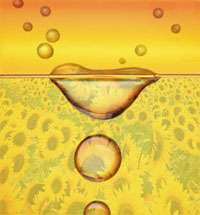Co-product from biodiesel production: Glycerine Renenue
The primary co-product from the production of biodiesel is glycerine. Glycerine is a clear, odourless and gel-like susntance that is comonly used in products such as pharmaceuticals, toothpaste, and cosmetics. It is usually defined as any product whose primary component is glycerol. It can be produced naturally as a co-product of fatty acid, fatty alcohol, or biodiesel production. As well, it can be produced synthetically. The production of biodiesel creates crude (low grade) glycerine that can be purified further at the plant site or sold to refineries that continue purification and in turn sell the glycerine for use as a raw material in other products.
Glycerine markets are renowed for their complecity and unpredictabiliyt. The demand, supply, and pricing of glycerine is determined through world market forces. Because glycerine is produced primarily ad a co-product, demand for the primary products influences the amount of glycerine produced. For example, in Europe the demand for biodiesel influences the amount of glycerine available for sale. As well, there are hundreds of potential end uses for glycerine, some of which can use competing products.
Glycerine has a variety of characteristics that make it ideal for numerous applications. Glycerine can remain colourless and odourless for a long period of time. When cold, glycerine does not freeze, but merely gels. Glycerine is about 55% to 75% as sweet as sugar. It is also non-toxic and does not irritate the skin.
Although glycerine has more than 1,500 uses, many prominent applications can be segmented into the categories of oral-care, food, tobacco, urethane foams, and pharmaceutical products.
Demand estimates for the consumption of glycerine by source type for Europe and North America is estimated at 50 to 60 % for vegetables/synthetic kosher quality of which 40 to 50 % is vegetable kosher only.
Some of the highest quality glycerine produced in the world us supplied by Malaysia and Indonesia. Both countries are big producers. Their glycerine is predominantly kosker certified and is produced from palm oil, whereas U.S> production is primarily synthetic or tallow based.
The glycerine produced by biodiesel plnats is a crude glycerine. In order to attract the higher prices of purified glycerine it must be upgraded.Crude glyrine can contain up to 10% water, 10% ash and 2.5% of other organic materials. It is generally upgrade by vacuum istillation or ion exchange refining. Both approahces increase the capital and oeprating costs of the biodiesel operation.


0 Comments:
Post a Comment
<< Home